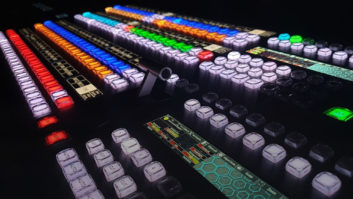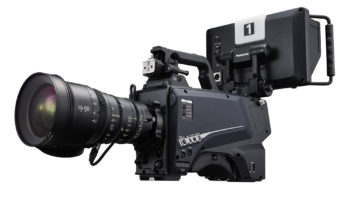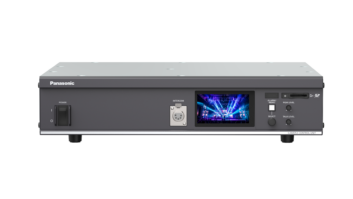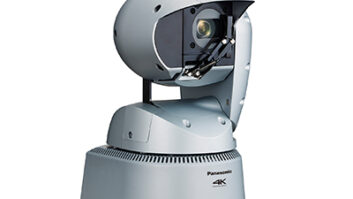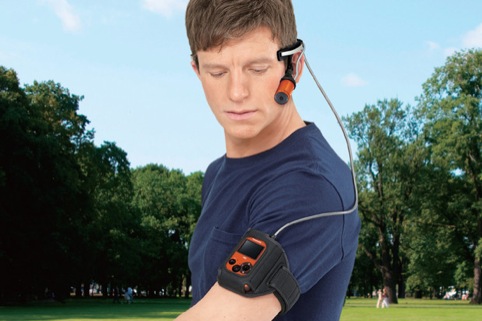
The world’s first 4K 25p wearable camcorder has been launched by Panasonic, as part of an Ultra HD ecosystem that encompasses home cinema, professional monitors, a new prosumer 4K DSLR, and its 4K VariCam broadcast camera launching at NAB.
The new, lightweight HX-A500 UHD action cam can also record HD at 50p, and is waterproof (to 3m for 30 minutes) and dustproof.
It features the umbilical design Panasonic has used previously for miniature cameras, with the 31g camera connected via a cable to the 119g operating and recording unit, which has a built-in 1.5-inch LCD monitor. The unit can connect via WiFi to a smartphone or tablet, and be used with Panasonic’s Image App to record and edit video remotely, share the result via social media, and transmit it live using UStream.
The unit uses a new high-speed image processor, Crystal Engine Pro+, with a new high sensitivity BSI sensor for low light. Other features include: Levelling Correction, Image Stabilisation and Loop recording.
The HX-A500 will be available from May priced £380, and can be fitted with a wide range of optional accessories, such as a new clip mount to easily attach the camera to a helmet or bag; or the ‘multi-case’ to combine the main unit, camera and cable into one body for single-handed use.
“We’ve seen the action camcorder market grow year on year as people look to share their activities and capture the action in the best picture quality possible,” said Matt Evans, camcorder product manager, Panasonic UK.
“4K is the next step in video capture and when combined with the ability to use a point-of-view camcorder we begin to push the boundaries of videography. The HX-A500 has the benefit of a lightweight lens piece, just 31g, which means using it becomes unobtrusive and it adds no significant bulk or weight to the user. This is a key point when you consider that an action camcorder will be used during an activity, such as skiing or sailing, so the less weight, or size, the better the experience.”
4K ecosystem
Besides the HX-A500, which is aimed at consumers, although professional users will probably find it equally useful, Panasonic has announced a host of 4K-enabled devices and technologies for the European consumer market, from TV sets (the UHD VIERA AX802 series feature HDMI 2.0 and 4K up-scaling) to up-scaling Blu-ray disc players and home theatre systems, and 4K-capable SD cards.
HDMI 2.0 allows 4K content to be transmitted at up to 60fps (the AX802 series also has a 60p-capable DisplayPort terminal for connecting to PCs or video games systems). The sets are also compatible with HEVC encoding.
Panasonic has also launched a new 4K-enabled stills/movie camera, the Lumix DMC-GH4, its most advanced Digital Single Lens Mirrorless (DSLM) interchangeable lens camera to date. The micro four-thirds lens mount camera can record 4K 24/25/30p video with a bitrate of 100Mbps (IPB) and is priced for prosumer use – it is currently available for pre-order at £1300 (inc VAT) or €1499.
VariCam goes 4K and high speed
At NAB next week, Panasonic will launch two new VariCam models, the VariCam 35 (shooting 4K Raw) and the high-speed VariCam HS.
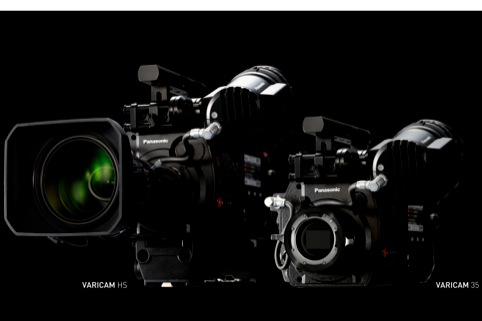
The PL-mount VariCam 35 (AU-V35C1) uses a newly-developed super 35mm MOS image sensor (4096×2160 – 17:9) and can shoot 4K, UHD, 2K and HD to make it suitable for high-end filmmaking, commercials and episodic production as well as live 4K events. Besides offering 4K RAW output, it can also record 4K, UHD, 2K and HD using Panasonic’s AVC-ULTRA codecs for more manageable production file sizes.
Its sensor boasts an impressive 14+ stops of latitude, and is claimed to faithfully capture high contrast, wide dynamic range imagery “without compromise”. It also has improved colour management capabilities to provide a much extended colour gamut for greater image fidelity, and supports the ACES (Academy Colour Encoding System) workflow for mastering.
The VariCam HS is the third generation HD VariCam since the introduction of the original in 2001, and can record at up to 240fps. It uses a modular design, where the camera head can be separated from the recording module, so that users can switch between super35 and 2/3-inch heads as needed.
The AU-V23HS1 high-speed camera head aimed at documentaries, sports or SFX slow motion applications has three 1920×1080 MOS imagers with 14 stops of dynamic range, and 1080p native recording, with the ability to ramp or change frame rates during record. It also has 24-bit LPCM audio and various creative image controls (such as matrix, detail, gammas and a new Log recording capability).
It offers a range of recording formats, including: AVC-Intra Class100 (recording as 1080/24p, 25/30p or 50/60p format) with variable frame rates (up to 240p); AVC-Intra Class200 (up to 30p/60i); and AVC-Intra Class4:4:4 (up to 30p – 240Mbps 10-bit 4:4:4). Both AVC-Intra Class200 and AVC-Intra Class4:4:4 deliver improved performance in applications where image quality is the primary consideration.
4K express
Panasonic is also introducing the next generation of P2 solid-state recording media at NAB: the expressP2 card. It is specifically designed to accommodate 4K image capture, and offers fast transfer speeds (up to 2.4Gbps.), meaning an hour of 4K footage can be transferred within about 10 minutes.
The expressP2 card AU-XP0256A contains a flash memory error correction system, equivalent to a RAID system, to recover from a failure in a sector, page, or entire block. It can be used in the new expressP2 card drive (AU-XPD1) to facilitate the fast offload of material at up to 2.4Gbps.
At NAB, Panasonic will be on booth #C3607 in the Central Hall.
By David Fox
